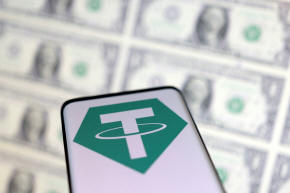U.S. crypto lobbyists in push to contain fallout from
stablecoin meltdown
 Send a link to a friend
Send a link to a friend
 [May 19, 2022] By
Hannah Lang [May 19, 2022] By
Hannah Lang
WASHINGTON (Reuters) - The cryptocurrency
industry is scrambling to respond to U.S. lawmakers' concerns about
stablecoins following the collapse of TerraUSD, which wiped billions off
the cryptocurrency market.
The Blockchain Association and the Chamber of Digital Commerce, which
represent some of the most influential crypto companies, say they have
been fielding a flurry of questions from Capitol Hill since TerraUSD,
known as "UST," broke its peg last week and crashed 90%.
Stablecoins are cryptocurrencies that try to maintain a constant
exchange rate with fiat currencies. The $163 billion space is dominated
by tokens that are pegged to the U.S. dollar, like Tether and USD Coin,
by holding reserves in traditional dollar assets. Some stablecoins, like
UST, however, use a complex algorithmic process to create the peg.
Capitol Hill lawmakers have been quizzing lobbyists on the structure of
UST, seeking to determine whether its collapse was preventable and if
other stablecoins could suffer the same fate.
Lobbyists are urging lawmakers not to crack down too hard on the gamut
of stablecoins.
“The one thing we've been cautioning to the Hill is that we don't want
to accidentally throw the baby out with the bathwater, because
stablecoins we think are a really critical piece of the crypto ecosystem
going forward,” said Kristin Smith, executive director of the Blockchain
Association.

As the cryptocurrency market has exploded, reaching $3 trillion in
November, the scrutiny of policymakers has increased.
In response, the crypto industry has beefed up its presence in
Washington, spending $9 million on lobbying in 2021, according to Public
Citizen. The Blockchain Association and Chamber of Digital Commerce
spent $900,000 and $426,663, respectively, while crypto giants Coinbase
Global Inc and Ripple Labs forked out $1.5 million and $1.1 million
respectively.
REGULATORY GRAY AREA
The industry's growing influence will be tested as it tries to contain
the fallout from the UST and broader crypto market crash, which shrank
from $1.98 trillion to $1.3 trillion in just six weeks due to investor
fears over rising interest rates.
There are currently a handful of draft stablecoin bills floating around
Congress. While analysts say the chances of Congress passing any of
those this year is slim with lawmakers focused on the midterm elections,
recent crypto market gyrations have caused many lawmakers to take
notice.
[to top of second column] |

Smartphone with Tether logo is placed on displayed U.S. dollars in
this illustration taken, May 12, 2022. REUTERS/Dado Ruvic/Illustration/File
Photo

“There are a lot of people in Congress that are interested in coming up with a
regulatory framework to prevent something like this from happening again,” said
Smith.
Cryptocurrencies fall into a regulatory gray area.
President Joe Biden's administration has largely focused on rules for
dollar-backed stablecoins. A November Treasury Department-led report recommended
Congress regulate stablecoin issuers like insured depository institutions, but
it did not cover algorithmic stablecoins.
Lobbyists have had to quickly change tack and educate lawmakers on the
differences, they say.
“All of the recent legislative proposals have been fiat-backed," said Cody
Carbone, policy director at the Chamber of Digital Commerce. "We thought we did
pretty well in educating because we stayed within that scope, and now we're
going to have to broaden that.”
While the group's members do not currently operate algorithmic stablecoins, the
chamber is crafting talking points to explain how they work, said Carbone.
Regulators have warned that U.S.-dollar stablecoins could be susceptible to runs
if users lose confidence, a fear that appeared to partially play out last week:
after UST broke its peg, Tether, the largest stablecoin, briefly broke its peg
too.
"This is essentially a call to action, because not all monies are created equal,
and what one believes to be stable may actually not be stable,” said Jonathan
Dharmapalan, CEO of eCurrency, a digital currency technology provider.
While the Blockchain Association's Smith agreed legislation was not imminent,
the UST problem “certainly heightens that need," she said.
(Reporting by Hannah Lang in Washington; Editing by Michelle Price and Matthew
Lewis)
[© 2022 Thomson Reuters. All rights
reserved.]This material may not be published,
broadcast, rewritten or redistributed.
Thompson Reuters is solely responsible for this content.
 |